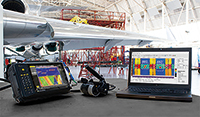Portable ultrasonic inspection solution
19/02/2019
Active with key industry players for 60 years, Sonatest, a leading ultrasonic non-destructive testing (NDT) manufacturer, has delivered its new generation of the popular RapidScan product family, the RSflite. Complemented by the agile WheelProbe2 linear array probe and the newly-developed UTmap stitching and analysis software, this latest Sonatest solution sets a new standard of performance, portability and efficiency for the inspection of simple to complex composite structures. Boosted by an impressive recording speed, the RSflite lightweight battery-operated equipment is two times faster than the previous generation. Handling small to large probes and with almost no file size limitation, it can rapidly cover large surfaces and spare precious inspection hours further down the production line or at the maintenance site. The RSflite responsive touch-screen user interface is also specifically optimised to operate a linear scan, saving significant training costs and time often associated with unnecessary advanced phased array ultrasonic testing (PAUT) concepts.
Boosted by an impressive recording speed, the RSflite lightweight battery-operated equipment is two times faster than the previous generation. Handling small to large probes and with almost no file size limitation, it can rapidly cover large surfaces and spare precious inspection hours further down the production line or at the maintenance site. The RSflite responsive touch-screen user interface is also specifically optimised to operate a linear scan, saving significant training costs and time often associated with unnecessary advanced phased array ultrasonic testing (PAUT) concepts.“Many people who use A-scan ultrasonic testing (UT) equipment are intimidated by the look and operation of advanced PAUT equipment. An instrument such as the Sonatest RSflite helps to bridge that gap because it is optimised for linear array composite testing,” said John Register, President at R-CON NDT. “It has no component for PAUT testing and thus makes the system very easy to learn and to operate.”
Ultrasonic NDT has helped engineers to inspect all sorts of composite materials for many years. Whether it be traditional aluminium laminates or the more complex carbon fibre-based composites of today, the fast Sonatest RSflite linear scanning technology, also called electronic scanning, offers the ability to acoustically see through these parts and create high-resolution inspection maps. Using the UTmap unique tiled-scan (T-scan) stitching capability, comprehensive volumetric integrity reports can be generated and supported by imaging reports that are as easy to interpret as traditional X-ray, without the hazard mitigation plan.
For the inspection of large composite structures, the position and overlap precision of the recorded ultrasonic information is a challenge in itself. The UTmap unique stitching capabilities resolve this issue, as each stripe of data (C-scan) can be re-gated and aligned precisely on the T-scan workspace. It is also possible to import computer-aided design (CAD)/image overlays and assemble C-scan stripes from different sections to create a meaningful image for analysis and reporting.
UTmap finally offers real-time contouring defect annotations with algorithms that provide precise and automatic measurements for fast defect interpretation and reporting.
www.sonatest.com